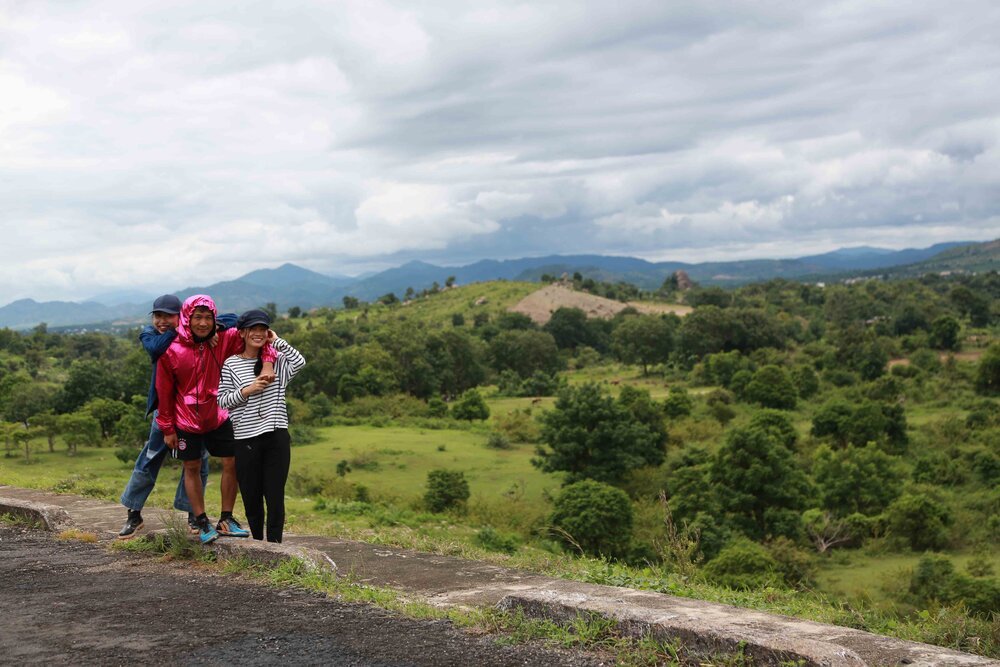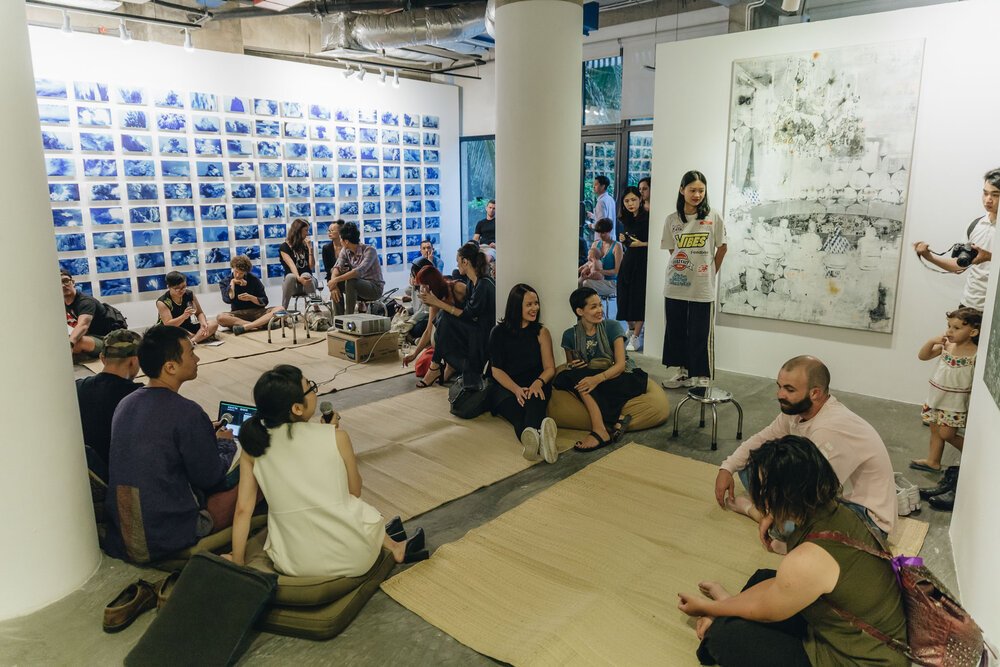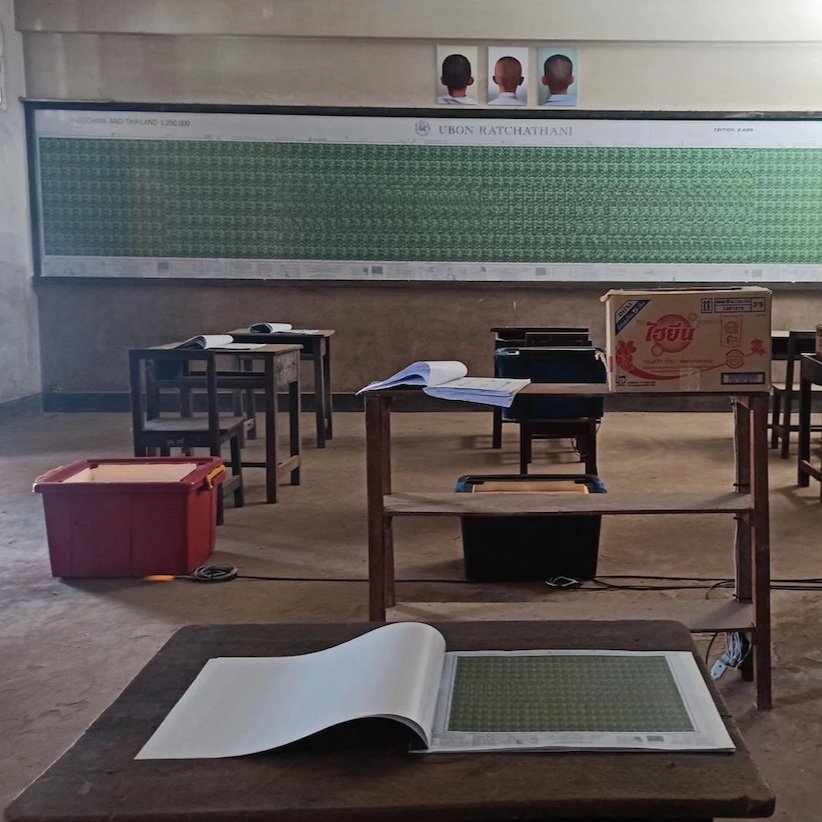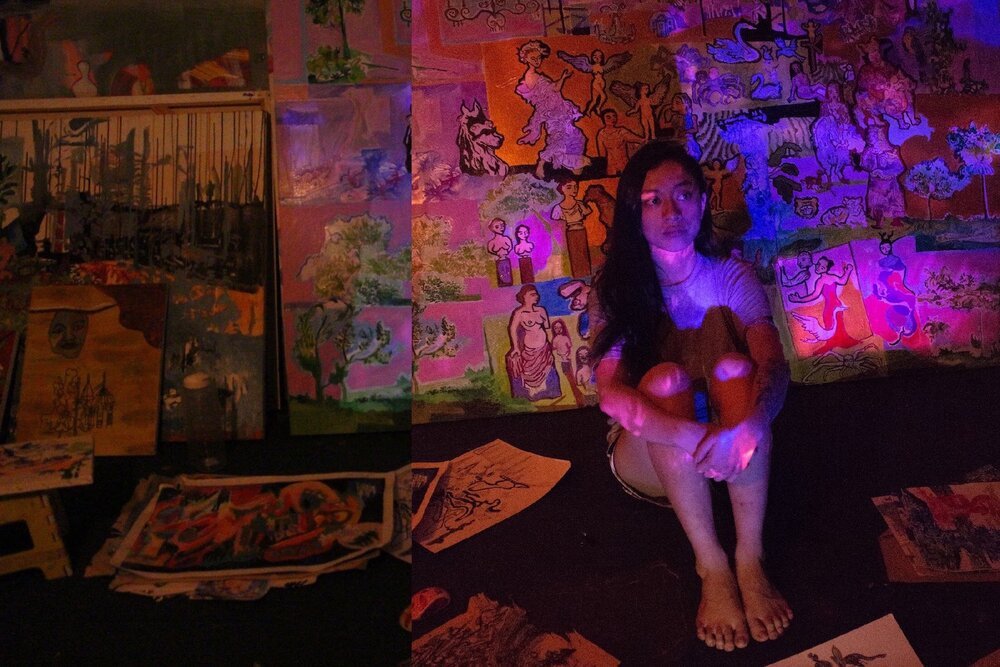Conversation with Arlette Quynh-Anh Tran
Post Vidai, Art Labor and developments in Vietnamese contemporary art
By Ian Tee
Arlette Quynh-Anh Tran.
Arlette Quynh-Anh Tran is a curator and writer based in Ho Chi Minh City, Vietnam. In 2016, she was appointed as the second director of Post Vidai, a collection founded by Daniel Howald, Tran Thanh Ha and Olivier Mourgue d’Algue. It is the largest collection of Vietnamese contemporary art, comprising more than 400 works from the 1970s to the present. Arlette is also a member of Art Labor, an artist collective with Truong Cong Tung and Phan Thao Nguyen. Their collaborative work straddles the domains of visual arts, social and life sciences, and often operates in public contexts. Art Labor's recent presentations include 'Seismic Movement' Dhaka Art Summit (2020), 57th Carnegie International (2018), and 6th Asian Art Biennale (2017-18).
In this conversation, Arlette shares her experiences as a young art practitioner as well as thoughts on the development of Vietnamese contemporary art.
Arlette and the late Huy Toan, one of the few war artists who survived the colonial war and the Vietnam War. Photo taken during her visit at his studio in Hanoi in September 2006. Image courtesy of Arlette Quynh-Anh Tran.
Could you talk about your background and interests at a young age? I understand that you were born in Germany and grew up in Ho Chi Minh City.
I was born in East Berlin, in the German Democratic Republic and returned to Vietnam at the age of 1. However, instead of returning to Hanoi, my parents' hometown, we went to Saigon. I insist on calling my city by that historical, vernacular name and it seems like I’m attached to the extinct part of divided countries during the Cold War, from Germany to Vietnam.
I was raised in a typical immigrant family in Saigon in the early 1990s, where my parents had their day jobs at state companies and then left to explore various businesses. I grew up seeing them enter a new field, experiment with it, struggle and experience failure, and then try something different. They applied that exploratory mindset in my upbringing, taking me to learn a lot of things: dance, music, visual art, etc. In the end, I was hooked on art.
Your first major curatorial experience was being an assistant to Ritrkit Tiravanija and Gridthiya Gaweewong for Saigon Open City (2006). It was a long-term art and cultural project that aimed to introduce contemporary art in everyday life. At that time, you were also studying International Commercial Law at the Vietnam National University.
How did you end up being involved in the project? And what was your takeaway from this experience?
It was the artist Richard Streitmatter-Tran who discovered me through my personal blog where I posted my drawings and writings about aesthetics and architecture. He introduced me to the underground, budding contemporary art circle in Saigon in the mid 2000s. I got to know wonderful artists who become friends such as Sandrine Llouquet, Việt Lê and Nguyen Nhu Huy, among others. Then, I worked part-time as a translator and research assistant for several visiting curators and researchers until Saigon Open City hired me to fill up the project’s vacant assistant curator position.
To be honest, I didn't realise then how fortunate I was to work alongside with p’Rirkrit, p’Jeab and the amazing artists involved in the exhibition. Although it could not open due to various reasons, the project had a knock-on effect on the generation of young, thirsty art practitioners in Saigon.
My job was a condensed curatorial course that any junior would dream of enrolling in. I learnt important lessons on art history and methodology that informed my practice later. I came to see art of the 1960s and 1970s in a new light, as not simply delineated by western artists such as Yoko Ono, Thomas Bayrle, Nancy Spero, but in relation to forgotten Northern Vietnamese artists such as Do Thi Ninh, Bang Lam, Huy Toan, Giang Khich. Saigon Open City also proposed the idea of interposition, by exhibiting thematic artworks in dialogue with various sites in the city, including spaces which might have nothing to do with art.
Art Labor collective, Arlette with co-founders Truong Cong Tung and Phan Thao Nguyen.
On Art Labor's website, the collective describes itself as not "producing single artworks but developing many-year-long journeys during which one inspiration is a seed to cultivate". What are the reason(s) for this way of working?
While each member has individual practices that deal with personal interests, Art Labor is our attempt at experimenting with the notion of "collectivity". We work as a trio and expand this triangle to broader communities and collaborators depending on the context. It is also a collective process of finding inspiration, turning it into ideas and deciding whether to execute them as artworks or engaging relationships.
Thus, it takes a long time to establish this state of being collective. We have to build trust in three areas: the ideas, if they are compelling or meaningful enough; the site or the land, if the environment grants us the suitable conditions for our ideas; and the people, if they want to join our journey and how we should negotiate the politics of collaboration.
Has Art Labor affected the way you think of curatorial practice?
It is in my nature to perpetually seek stimuli through thoughts and ideas. This drives me to read, listen to, talk to, observe others and find ways to accommodate them into my conceptual constellation. This approach applies to all of my practices.
'Jrai Dew 2' in Blut Grieng village, Gia Lai province, Central Highland, Vietnam. With artworks from Art Labor’s collaborative Jrai artists including Rcham Jeh, Kpuih Gloh, Puih Hăn, Siu Lơn, Rơmah Hyet, and Rahlan Lơh. Image courtesy of Art Labor.
You were involved in digitising the Archival Materials of Blue Space Contemporary Arts Centre, a project initiated by Asia Art Archive (AAA) and Professor Nora A. Taylor. Blue Space, or Khong Gian Xanh in Vietnamese, was founded in 1996 as an independent art space for artists to exercise their freedom of expression. It was housed in the Ho Chi Minh City Museum of Fine Arts, though its operations were completely independent of that institution.
Could you talk more about its founder Mrs. Tran Thi Huynh Nga and Blue Space's impact on the development of contemporary art in Vietnam?
This project took place between 2011 and 2013, while I was studying art history and philosophy in Berlin. I first heard about Mrs. Nga and her Blue Space when I was working on Saigon Open City. However, she was semi-retired at the time to take care of her late husband, the painter Tran Trung Tin. I only came to recognise how important her space was to the birth of the Saigonese contemporary art scene after being involved with AAA's project.
Unlike the current situation where Hanoi, Saigon and Hue each have their own art scene, Vietnamese art was predominantly represented through the Hanoi lens then. Saigon was not considered a focal point for the arts and there were many reasons for this. Generations of thinkers, writers, and artists were removed from cultural memories after the Vietnam War ended. The government directed Saigon as merely an economic and industrial centre. Even the strong ‘Group of 10’ abstract artists, which includes Nguyen Trung, Tran Van Thao, Do Hoang Tuong and others, were seen as commercially successful but not seriously evaluated in art history.
Blue Space was born under such circumstances, with the ambition to be a platform for young artists in Saigon to experiment. It quickly became the salon for avant-garde artists which was a mix of local Vietnamese and returning Viet Kieu. Jun Nguyen Hatsushiba had his first solo exhibition in Vietnam there. Seiji Shimoda talked about performance art to enthusiastic art students including Ly Hoang Ly and Bui Cong Khanh, who later presented their first performance piece at Blue Space. It was also the venue for the performance festival Asiatopia, and Sandrine Llouquet and Richard Streitmatter-Tran's multimedia projects before their Wonderful District era.
Remember that Blue Space is located inside the conservative, outdated Fine Arts Museum too, and what an agonistic move that was!
Reflecting on your journey as a young curator, what were the key factors that helped you sustain your practice?
I am very fortunate to have worked with and maintained relationships with my mentors: Rirkrit Tiravanija, Ong Keng Sen, Carolyn Christov-Bakargiev and Zoe Butt. They have taught me unorthodox methodologies, moral values, organisational skills and to trust my intuition. These are survival strategies that also sustain my practice intellectually.
Propeller Group, 'AK-47 vs M-16', 2015, exhibition installation view in 'The Picture Will Still Exist' (2017). Image courtesy of Post Vidai.
Photo taken at an event organised in conjunction with 'The Picture Will Still Exist' (2017), an exhibition of works in Post Vidai curated by Arlette Quynh-Anh Tran. Image courtesy of Post Vidai
In your Frieze Academy presentation on Post Vidai, you spoke about the term "Vidai" and how the collection's name reflects its focus. What does Post Vidai mean? And how does it relate to the scope of the collection?
In Vietnamese, "Vidai" means grandiose. It was a term popularly used in socialist propaganda slogans and posters during the pre-Doi Moi period. Thus, Post Vidai suggests a transition into the era of radical social and economic reform in Vietnam since the late 1980s and especially after the US lifted their embargo in 1996. It also marks the period when Vietnamese artists started to explore unconventional modes of expression and topics previously considered taboo.
The collection focuses on various approaches to understand this transition. At the beginning, we acquired artworks that archive the rapid transformation of Vietnamese society or examples of artistic breakthroughs. Two decades later, the collection is stimulated with works that exemplify the idea of evolution, whether thematically or aesthetically. Examples include Sung Tieu's 'Memory Dispute', a work that connects wartime dioxin in the forest with horrific environmental disasters along coast of Central Vietnam from the last decade; and Truong Cong Tung's work which is a vernacular take on arte povera.
Tran Van Thao, ‘Space in the City’, 1999, mixed media on canvas, 135 x 200cm. Image courtesy of Post Vidai.
While the aftermath of the Vietnam war and sociopolitical themes may typify common perception of Vietnamese contemporary art, the collection also holds key examples of abstract painting by Nguyen Trung, Tran Van Thao and Do Hoang Tuong, among others. Why is it important to highlight this genre of works in the collection? Could you talk about the significance of these Saigon artists in the discourse of abstract painting in Vietnam?
If you visit the Fine Arts Museum, you can see the wonderful abstract painting ‘Cat Canh / Ascent’ (1972) by Ta Ty, my all-time favourite painter. He and other abstract artists in Saigon escaped the country after 1975, and there is hardly any art historical record about abstraction before this period. This abruption lasted until the emergence of the "Group of 10", a new wave of abstract painters in Saigon in the late 1980s and early 1990s. While western modernist discourse had an impact in South Vietnam due to American influence, we need to detach from this framework to understand these artists.
They utilised abstraction as a tool of resistance to demonstrate their weariness of state-led socialist realism and romantic depictions of the landscape. Abstraction was an escape route from staged realism, towards a more ‘real’ manifestation. In an interview with the artist Tran Van Thao, he told me that he painted ‘Space in the City’ (1999) because he felt that whirlwind urbanisation had completely changed his Saigon cityscape. To him, no propaganda or peaceful painting could capture such a scene.
Behind the scenes filming Post Vidai's interview with artist Ngoc Nau in Thai Nguyen province. Image courtesy of Post Vidai.
In a 2017 interview with Art Radar, you said, "Lacking platforms for art criticism, art history and an art market, the lifespan of artistic creation in Vietnam depends wholly on narrations from the outside." What are your thoughts on the local and international markets for Vietnamese contemporary art? How might private initiatives, such as Post Vidai, steer the conversation?
For a long time, Vietnamese contemporary art was dependent on international acquisitions from foreign museums and collectors. However, in the last two years, I have noticed a strong will from local collectors to change this trend. They've moved from collecting only Vietnamese modern art to purchasing more works by living contemporary artists. Post Vidai sees this development as a very positive sign for the art scene here and our next aim is to increase knowledge on the history of Vietnamese contemporary art.
We hope to generate critical discourse on Vietnamese art with regional, comparative perspectives instead of a Western-centric framework. This is done through our series of artist interviews and upcoming research publications, which are targeted at both local and international audiences. We advocate for the evaluation of artworks based on academic research, meaningful engagement with society, and its contribution to aesthetic development rather than market speculation. It is important to support progress in a healthy, sustainable manner.
Currently, you are pursuing your masters at the California Institute of Arts (CalArts). How is the experience thus far? And what do you hope to get out of it?
I am a Masters candidate of Aesthetics and Politics at CalArts as a Fulbright scholarship recipient. Prior to this, I was searching for a programme to study theory along with art making. It was p’Rirkrit who told me that I should move to CalArts, where I could spend time in solitude to read and experiment, rather than the over-stimulating New York. He was right! Besides theory-based classes, I have also studied Blues music, Third Cinema, Black conceptual art, and even learnt to create animation, which CalArts is known for!
Right now I’m researching for my thesis on the South Vietnamese government's efforts at nation building in the 1960s and its representation through the aesthetics of modernist architecture.
Lang Do, 'Note #1', 2019, acrylic on canvas on clear plastic sheet. Image courtesy of the artist.
Do you have any upcoming projects you'd like to share?
I am very much looking forward to solo exhibitions of Ngo Dinh Bao Chau and Lang Do which I am curating. They will open at Galerie Quynh in the second half of 2020!
















